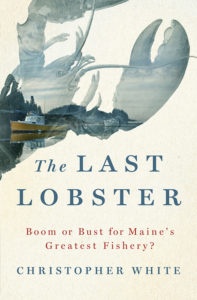PUBLISHER’S WEEKLY REVIEW of The Last Lobster
The Last Lobster: Boom or Bust for Maine’s Greatest Fishery?

Agent: Lauren McLeod, the Strothman Agency. Release date: June 2018.
In this illuminating volume, White (The Melting World: A Journey Across America’s Vanishing Glaciers) sets out to capture the look and feel of traditional Maine lobster villages. According to White, a climate-affected fluctuation in lobster populations may be endangering the industry and the Maine culture it supports. Early chapters introduce locals such as Frank Gotwals and Julie Eaton. The former is a 60-year-old self-taught boat captain who chose the fishing life “because his ancestors had.” On the water, he is “solitary [and] self-reliant… Sherlock Holmes without a Watson.” The latter, a boat captain and nature photographer who describes herself as “addicted to the water,” is among the few women in a male-dominated business; she says that her marriage to a fellow lobster captain has been saved by having separate boats. White talks at length with lobster boat captains, resource managers, and scientists about what caused the extreme growth of the lobster population (and the subsequent lowering of prices), how long it might last, and the industry’s future. He affectionately observes the sights and sounds on the water, the relationships between the boat captains and their “sternmen” (both male and female), the idiosyncratic techniques they use to decide where to place traps, the norms and customs of the fishery (for example, marking and returning to the water pregnant lobsters, called “eggers”), the fluctuations of bait and lobster prices, and discussions between fishers about global warming, regulations, and whether or not to unionize. White conveys the significance of lobsters to people all over the world in this enjoyable sojourn with the lobster folk.

